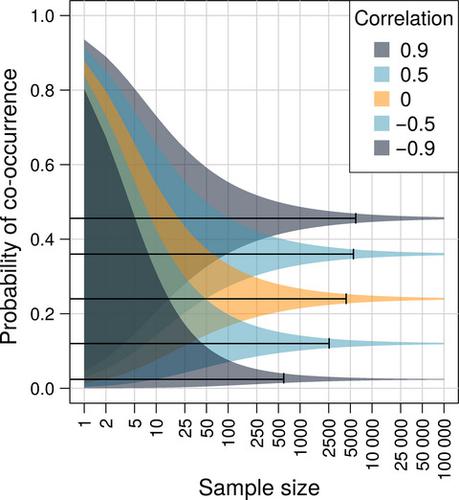当前位置:
X-MOL 学术
›
Ecol. Lett.
›
论文详情
Our official English website, www.x-mol.net, welcomes your feedback! (Note: you will need to create a separate account there.)
Co-occurrence is not evidence of ecological interactions.
Ecology Letters ( IF 8.8 ) Pub Date : 2020-05-19 , DOI: 10.1111/ele.13525 F Guillaume Blanchet 1 , Kevin Cazelles 2 , Dominique Gravel 1
Ecology Letters ( IF 8.8 ) Pub Date : 2020-05-19 , DOI: 10.1111/ele.13525 F Guillaume Blanchet 1 , Kevin Cazelles 2 , Dominique Gravel 1
Affiliation

|
There is a rich amount of information in co‐occurrence (presence–absence) data that could be used to understand community assembly. This proposition first envisioned by Forbes (1907) and then Diamond (1975) prompted the development of numerous modelling approaches (e.g. null model analysis, co‐occurrence networks and, more recently, joint species distribution models). Both theory and experimental evidence support the idea that ecological interactions may affect co‐occurrence, but it remains unclear to what extent the signal of interaction can be captured in observational data. It is now time to step back from the statistical developments and critically assess whether co‐occurrence data are really a proxy for ecological interactions. In this paper, we present a series of arguments based on probability, sampling, food web and coexistence theories supporting that significant spatial associations between species (or lack thereof) is a poor proxy for ecological interactions. We discuss appropriate interpretations of co‐occurrence, along with potential avenues to extract as much information as possible from such data.
中文翻译:

共存不是生态相互作用的证据。
同现(存在/不存在)数据中包含大量信息,可用于了解社区集会。福布斯(1907年)和戴蒙德(1975年)首先提出的这一主张促使了许多建模方法的发展(例如,空模型分析,共现网络,以及最近的联合物种分布模型)。理论和实验证据均支持生态相互作用可能影响共现的观点,但目前尚不清楚在观测数据中可以在多大程度上捕获相互作用的信号。现在是时候退出统计数据的发展,并严格评估同现数据是否真的可以替代生态相互作用。在本文中,我们提出了一系列基于概率,抽样,食物网和共存理论支持物种之间重要的空间关联(或缺乏物种之间的关联)不能很好地代表生态相互作用。我们讨论对共现的适当解释,以及从这些数据中提取尽可能多信息的潜在途径。
更新日期:2020-05-19
中文翻译:

共存不是生态相互作用的证据。
同现(存在/不存在)数据中包含大量信息,可用于了解社区集会。福布斯(1907年)和戴蒙德(1975年)首先提出的这一主张促使了许多建模方法的发展(例如,空模型分析,共现网络,以及最近的联合物种分布模型)。理论和实验证据均支持生态相互作用可能影响共现的观点,但目前尚不清楚在观测数据中可以在多大程度上捕获相互作用的信号。现在是时候退出统计数据的发展,并严格评估同现数据是否真的可以替代生态相互作用。在本文中,我们提出了一系列基于概率,抽样,食物网和共存理论支持物种之间重要的空间关联(或缺乏物种之间的关联)不能很好地代表生态相互作用。我们讨论对共现的适当解释,以及从这些数据中提取尽可能多信息的潜在途径。


























 京公网安备 11010802027423号
京公网安备 11010802027423号